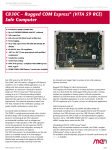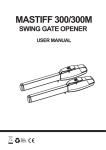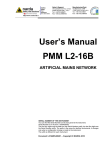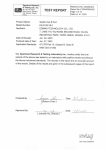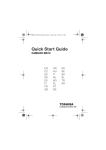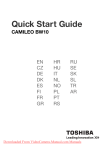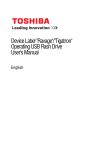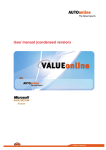Download User Manual - Newegg.com
Transcript
User Information Guide TOSHIBA CB30 Check the Components Your computer comes with: ■ AC adaptor (2-pin or 3-pin) ■ Several documents, including Instruction Manual for Safety and Comfort. If any of the items are missing or damaged, contact your dealer immediately. English All product specifications, configurations, prices, system/component/options availability are all subject to change without notice. Charging Your Computer Your computer contains a rechargeable battery that may need to be charged prior to use. Depending on the model, either a 2-pin or 3-pin AC adaptor will be bundled with the computer. 1. Connect the provided AC adaptor to the computer. 2. Plug the AC adaptor into a wall outlet. The DC IN/ Battery indicator should glow amber. 2pin 2pin 2 3pin 3pin The computer can not be powered on if the battery power is completely exhausted. It is recommended to charge the battery pack by connecting the AC adaptor for 30 minutes before turning on the power. User Information Guide Turning on/off the Power You can turn on the power by opening the display panel or by pressing the Power button. The Power indicator located on the Power button glows white when the computer is on. To turn the computer off: ■ Shut down: press and hold the Power button until the Power indicator is off. ■ Sleep mode: close the display panel. Automatic Sleep Mode By default, the system is set to automatically enter sleep mode after some minutes of inactivity to save power. The Power indicator then flashes white to indicate that the computer is in the sleep mode. To manually enter sleep mode, you can just close the display panel. To resume from sleep mode, simply open the display panel or press any key on the keyboard. User Information Guide 3 English To open the display, slowly lift the display panel while holding down the palm rest with one hand. Then adjust the angle of the display panel for optimum clarity. Initial Setup When using the computer for the first time, there are a few basic steps to go through before the computer is ready for use. 1. Choose your preferred system language. If there are more than one keyboard for this language, you’ll need to select one from the drop-down list. 2. Connect your computer to a nearby Wi-Fi network for Internet connection. English 3. Once the computer gets connected, click Continue. You’ll need to accept the terms of service and the system will then download any available updates so you automatically get the latest features. 4. Sign in with a Google Account. If you don’t have one, click create a Google Account and follow the instructions to complete the creation. You can also use the computer without a Google Account, that is, as a guest by clicking browse as Guest. 5. Choose a picture or take a photo with the built-in web camera to represent your account, and you will be logged in with your Google account. Getting More Tips To find more tips on using your computer, please follow the steps below: 1. Connect your computer to a nearby Wi-Fi network with Internet access. 2. Sign in with a Google Account. If you don’t have one, register a new Google Account. 3. Press 4 on the keyboard which brings up the App list and then click Get Started app. User Information Guide Quick Tour 3 1 4 2 8 9 6 7 6 12 13 14 15 User Information Guide 10 11 English 5 1. Wireless communication antennas (not shown) 2. Microphone 3. Web Camera LED 4. Web Camera 5. Display screen 6. Display hinges 7. Keyboard 8. Power button 9. Power indicator 10. Touch Pad 11. Touch Pad control button 12. Security lock 13. DC IN 19V jack 14. DC IN/Battery indicator 15. Memory media slot Product appearance depends on the model you purchased. 5 English Right side 1 2 3 1. Headphone/Microphone combo jack 2. USB 3.0 port 3. USB 3.0 port 4. HDMI port 5. Speakers 6. Cooling vents 4 Underside 6 6 Product appearance depends on the model you purchased. 5 6 5 User Information Guide Keyboard Features The keyboard on your computer provides several buttons to help you quickly access common functions. Button Description Button Description Decrease screen brightness. Go to the next page. Increase screen brightness. Reload your current page. Mute the sound. Maximize your window. Decrease the volume. Go to the thumbnails of all your open apps. Increase the volume. ■ Power on/off the computer. Search the apps from the App list. English Go to the previous page. ■ Lock the screen: press until the sign-in screen appears. User Information Guide 7 DC IN/Battery Indicator English The DC IN/Battery indicator on the left side of the computer indicates the power conditions as detailed in the following table. Amber Indicates the AC adaptor is connected and the battery is charging. Green Indicates the AC adaptor is connected and the battery is fully charged. No light Under any other conditions, the indicator does not light. Battery Charging & Exhausting Time The approximate time required to fully charge a discharged battery is as follows: Power off (sleep, shut down): about 3 hours When you turn off the power of your computer with the battery fully charged, the battery will be exhausted within the following approximate period: Power off (sleep, shut down): about 43 days Power on: up to 9 hours The computer’s battery is not accessible by the user. 8 User Information Guide Connecting Peripheral Devices Memory media The computer is equipped with a memory media slot that can accommodate some kinds of memory media such as Secure Digital (SD) Card and MultiMediaCard (MMC). Please note that not all memory media have been tested and verified to work correctly. Therefore, it is not possible to guarantee that all memory media will operate properly. 1. Turn the memory media so that the contacts (metal areas) face down. 2. Insert the memory media into the memory media slot on the computer. 3. Press the memory media gently until it clicks into place. User Information Guide 9 English The following instructions apply to all types of supported media devices. To insert memory media, follow the steps below: HDMI device HDMI (High-Definition Multimedia Interface) port digitally transfers both video and audio data without reducing the quality. To connect an HDMI-compatible display device, follow the steps as detailed below: English 1. Plug one end of the HDMI cable into the HDMI in port of the HDMI display device. 2. Plug the other end of the HDMI cable into the HDMI port on your computer 3. Turn the HDMI display device's power on. Not all the port operations of HDMI display devices have been confirmed, some HDMI display devices may not function properly. Security lock A security lock enables you to anchor your computer to a desk or other heavy object in order to help prevent unauthorized removal or theft. To connect a security cable to the computer, follow the steps as detailed below: 1.Turn the computer so its left side faces you. 2.Align the security cable with the lock slot and secure it in place. 10 User Information Guide Specifications The following table shows the physical dimensions and other relevant specifications of the computer. Size 328.6 (w) x 227 (d) x 13.7/20.2 (h) millimeters (not including parts that extend beyond the main body and the dimensions may vary depending on the model you purchased) Ambient temperature Operating: 5°C (41°F) to 35°C (95°F) English Non-operating: -20°C (-4°F) to 60°C (140°F) Relative humidity Operating: 20% to 80% (noncondensing) Non-operating: 10% to 90% (noncondensing) Altitude (from sea level) Operating: -60 to 3,000 meters Non-operating: -60 to 10,000 meters maximum Battery type Battery pack (52Wh, 4 cell) Power requirements AC adaptor: 100-240V AC, 50 or 60 Hz (cycles per second) Computer: 19V DC User Information Guide 11 Copyright © 2013 by TOSHIBA Corporation. All rights reserved. Under the copyright laws, this manual cannot be reproduced in any form without the prior written permission of TOSHIBA. No patent liability is assumed, with respect to the use of the information contained herein. English First edition December 2013 Disclaimer This manual has been validated and reviewed for accuracy. The instructions and descriptions it contains are accurate for your computer at the time of this manual’s production. However, succeeding computers and manuals are subject to change without notice. TOSHIBA assumes no liability for damages incurred directly or indirectly from errors, omissions or discrepancies between the computer and the manual. Trademarks Google, Chrome, Chromebook and the Chrome logo are registered trademarks or trademarks of Google Inc. The terms HDMI and HDMI High-Definition Multimedia Interface, and the HDMI Logo are trademarks or registered trademarks of HDMI Licensing LLC in the United States and other countries. All other product names and service names in this manual may be trademarks or registered trademarks of their respective companies. 12 User Information Guide EU Declaration of Conformity This product is carrying the CE-Mark in accordance with the related European Directives. Responsible for CE-Marking is TOSHIBA EUROPE GMBH, Hammfelddamm 8, 41460 Neuss, Germany. The complete and official EU Declaration of Conformity can be found on TOSHIBA’s web site http://epps.toshiba-teg.com on the Internet. Following information is only valid for EU-member States: The crossed out wheeled dust bin symbol indicates that products must be collected and disposed of separately from household waste. Integrated batteries and accumulators can be disposed of with the product. They will be separated at the recycling centres. The black bar indicates that the product was placed on the market after August 13, 2005. By participating in separate collection of products and batteries, you will help to assure the proper disposal of products and batteries and thus help to prevent potential negative consequences for the environment and human health. For more detailed information about the collection and recycling programmes available in your country, please visit our website (http://eu.computers.toshiba-europe.com) or contact your local city office or the shop where you purchased the product. User Information Guide 13 English Disposal of products Disposal of batteries and/or accumulators The crossed out wheeled dust bin symbol indicates that batteries and/or accumulators must be collected and disposed of separately from household waste. If the battery or accumulator contains more than the specified values of lead (Pb), mercury (Hg), and/or cadmium (Cd) defined in the Battery Directive (2006/66/EC), then the chemical symbols for lead (Pb), mercury (Hg) and/or cadmium (Cd) will appear below the crossed out wheeled dust bin symbol. English By participating in separate collection of batteries, you will help to assure the proper disposal of products and batteries and thus help to prevent potential negative consequences for the environment and human health. For more detailed information about the collection and recycling programmes available in your country, please visit our website (http://eu.computers.toshiba-europe.com) or contact your local city office or the shop where you purchased the product. These symbols may not stick depending on the country and region where you purchased. 14 User Information Guide REACH - Compliance Statement The new European Union (EU) chemical regulation, REACH (Registration, Evaluation, Authorization and Restriction of Chemicals), entered into force on 1 June 2007. TOSHIBA will meet all REACH requirements and is committed to provide our customers with information about the chemical substances in our products according to REACH regulation. Disposing of the Computer and the Computer's Battery Contact an authorized TOSHIBA service provider for details regarding how to dispose of the computer and the battery. User Information Guide 15 English Please consult the following website www.toshiba-europe.com/computers/info/reach for information about the presence in our articles of substances included on the candidate list according to article 59(1) of Regulation (EC) No 1907/2006 („REACH“) in a concentration above 0.1 % weight by weight. ENERGY STAR® Program Your Computer model may be ENERGY STAR® compliant. If the model you purchased is compliant, it is labeled with the ENERGY STAR logo on the computer and the following information applies. English TOSHIBA is a partner in the ENERGY STAR Program and has designed this computer to meet the latest ENERGY STAR guidelines for energy efficiency. Your computer ships with the power management options preset to a configuration that will provide the most stable operating environment and optimum system performance for both AC power and battery modes. To conserve energy, your computer is set to enter the low-power Sleep Mode which shuts down the system within 30 minutes and the display within 8 minutes of inactivity in AC power mode. TOSHIBA recommends that you leave this and other energy saving features active, so that your computer will operate at its maximum energy efficiency. You can wake the computer from Sleep Mode by pressing the power button. Products that earn the ENERGY STAR prevent greenhouse gas emissions by meeting strict energy efficiency guidelines set by the US EPA and the EU Commission. According to the EPA, a computer meeting the new ENERGY STAR specifications will use between 20% and 50% less energy depending on how it is used. Visit http://www.eu-energystar.org or http://www.energystar.gov for more information regarding the ENERGY STAR Program. 16 User Information Guide Information for Wireless Devices Wireless devices and your health Wireless products, like other radio devices, emit radio frequency electromagnetic energy. The level of energy emitted by Wireless products however is far much less than the electromagnetic energy emitted by wireless devices like for example mobile phones. In some situations or environments, the use of Wireless products may be restricted by the proprietor of the building or responsible representatives of the organization. These situations may for example include: ■ Using the Wireless products equipment on board of airplanes, or ■ In any other environment where the risk of interference to other devices or services is perceived or identified as harmful. If you are uncertain of the policy that applies on the use of wireless devices in a specific organization or environment (e.g. airports), you are encouraged to ask for authorization to use the Wireless device prior to turning on the equipment. User Information Guide 17 English Because Wireless products operate within the guidelines found in radio frequency safety standards and recommendations, TOSHIBA believes Wireless products is safe for use by consumers. These standards and recommendations reflect the consensus of the scientific community and result from deliberations of panels and committees of scientists who continually review and interpret the extensive research literature. Canada - Industry Canada (IC) This device complies with RSS 210 of Industry Canada. Operation is subject to the following two conditions: (1) this device may not cause interference, and (2) this device must accept any interference, including interference that may cause undesired operation of this device. The term "IC" before the equipment certification number only signifies that the Industry Canada technical specifications were met. English USA-Federal Communications Commission (FCC) This equipment has been tested and found to comply with the limits for a Class B digital device, pursuant to Part 15 of FCC Rules. These limits are designed to provide reasonable protection against harmful interference in a residential installation. TOSHIBA Support If you require any additional help using your computer or if you are having problems operating the computer and suspect that it is hardware related, you may need to contact TOSHIBA for additional technical assistance. Visit TOSHIBA technical support website: www.toshiba-europe.com 18 User Information Guide


















